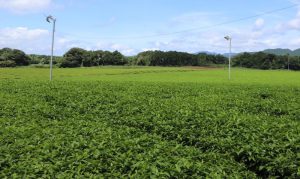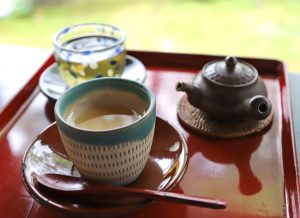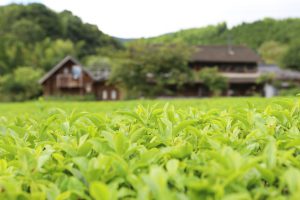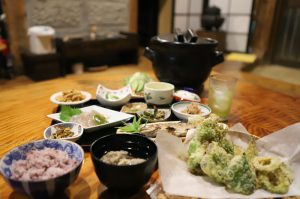MENU
MENU
Tea production area: Aso City, Yamaga City, Arao City, Tamana City, Kikuchi City, Kumamoto City, Kamimashiki City, Uto City, Uki City, Yatsushiro City, Kuma County, Hitoyoshi City, Ashikita City, Minamata City, Amakusa City
Brand: Kumamoto tea, Hitoyoshi-kuma tea, etc.
Types of tea: Kamairicha (pan-fired green tea), mushisei-tamaryokucha (steamed curly green tea), sencha (lightly-steamed green tea), fukamushicha (deep-steamed green tea), gyokuro (high quality shaded tea), matcha, kamairicha (pan-fired green tea), kukicha (stem tea), hojicha (roasted green tea), genmaicha (green tea with roasted rice), black tea, bancha, powdered tea, etc.
Kumamoto tea
Kumamoto Prefecture is abundant in water and tea is cultivated from the coastal areas to the mountainous areas. Tea cultivated and produced in Kumamoto Prefecture is collectively called Kumamoto tea. However, there are tea brands for each region such as Hitoyoshi-kuma tea, etc.
Kuma District is the largest tea production area where there are the Kuma River and the Kawabe River.
An old document mentions that tea was cultivated in the 12th century in Sagara Village, Kuma Country.

Tea fields along the fluty road in Sagara Village (August 2018)
Musisehi-tamaryokucha (steamed curly green tea)
Mainly mushisei-tamaryokucha is produced in Kumamoto Prefecture. The tea leaves of mushisei-tamaryokucha is not formed using a machine like standard sencha (steamed green tea). The shape of tea leaves is twisted having a rounded shape.

Musisehi-tamaryokucha at Tateishi shoten in Hitoyoshi City (August 2018)

Bancha pudding and bancha Machiya Gallery Tateyama (August 2018)
Tea tourism
You can enjoy tea tourism in Kumamoto Prefecture.
Tateyama shoten in Hitoyoshi City provides some activities for tourists such wearing Kimono, making sencha with kyusu (a Japanese tea pot) or matcha.
There is a tea farm inn Chanomi in Minakami Village. Beautiful tea fields extend in front of the cottage for the guests. The dinner for the guests are made using the tea leaves, vegetable and ingredients which are made by themself and fresh local fish.

Tea farm inn Hamakawaen Chanomi in Minakami Village (August 2018)

Dinner at Chanomi (August 2018)
Tea related facilities:
立山商店 https://www.tateyamasyoten.com
町屋ギャラリー立山 https://www.tateyamasyoten.com/machiya/
浜川園製茶農家の宿茶乃実 https://www.facebook.com/hamakawa.cha.nomi/
Tea mascot Yuru-Chara:
Ceramic and pottery art: Amakusa-toujiki, Shodai ware, Kouda Ware
Reference:
松下智 (平成3年) 日本名茶紀行 (初版) 雄山閣出版
高野實・谷本陽蔵・富田勲・中川致之・岩浅潔・寺本益英・山田新市 (2005) 緑茶の事典 (改訂3版) 柴田書店
大森正司、阿南豊正、伊勢村護、加藤みゆき、滝口明子、中村羊一郎編(2017) 茶の事典 初版第一刷 朝倉書店
くまもと茶Navi http://kumamoto-cha.jp
水上村観光協会 http://mizukami.net
*When visiting the shops and facilities introduced in this article, please check the business hours on their website, etc. before visiting.
*The information provided on this site may be updated. If you find any information in this article that is incorrect, new, or incomplete, please contact CHAMART.
*The site does not describe all “Teas of Japan” or all “Teas of the World”. Additionally, each article expresses the writer’s personal experience and feelings.
#kumamototea #kumamoto